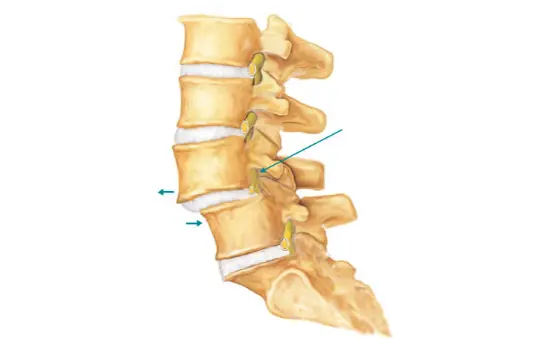Vertebral Slippage in the Lower Back Leading to Pain and Instability
What Is Lumbar Spondylolisthesis?
Lumbar spondylolisthesis is a condition in which one vertebra in the lower spine slips forward over the vertebra beneath it. This misalignment can cause pressure on nearby nerves, leading to pain in the lower back, buttocks, or legs. The condition may develop due to wear and tear (degenerative), a defect or fracture in a vertebra (isthmic), or less commonly, from trauma or congenital factors.
Causes and Risk Factors
- Degenerative changes in the facet joints and discs
- A stress fracture (spondylolysis) in the vertebral arch
- Congenital spinal abnormalities
- High-impact sports or repetitive hyperextension activities
- Aging, obesity, and a family history of spine conditions
Symptoms
- Lower back pain that worsens with activity or prolonged standing
- Tightness or spasms in the hamstrings
- Radiating pain, numbness, or tingling down one or both legs (sciatica-like symptoms)
- Difficulty walking or standing for extended periods
- In severe cases, leg weakness or changes in bowel or bladder control (rare and urgent)
Diagnosis
- Thorough physical examination, including assessment of flexibility and neurological function
- Imaging tests:
- X-rays (standing) to evaluate vertebral alignment and slippage
- MRI to assess nerve compression and disc health
- CT scan may be used to visualize bony detail or stress fractures
Treatment
Non-Surgical Treatment
- Recommended for patients with mild to moderate symptoms
- May include:
- Activity modification and avoidance of aggravating movements
- NSAIDs or other pain medications
- Core strengthening and flexibility exercises through physical therapy
- Epidural steroid injections for nerve-related pain
Surgical Treatment
- Considered when non-surgical methods fail or if there is progressive slippage or neurological symptoms
- Common procedures:
- Spinal fusion to stabilize the affected vertebrae using bone grafts and instrumentation
- Decompression (e.g., laminectomy) if nerve roots are compressed
- Minimally invasive fusion techniques may be an option for eligible patients
Recovery Timeline
- Non-surgical recovery usually occurs over 6–12 weeks with therapy and lifestyle adjustments
- Post-surgical recovery from spinal fusion typically involves:
- 6–8 weeks of limited activity
- Gradual return to normal function over 3–6 months
- Full fusion and long-term recovery assessed around 9–12 months
Expert Treatment at Kerlan Jobe Institute
Kerlan Jobe Institute provides comprehensive care for lumbar spondylolisthesis, from diagnosis to individualized treatment planning. Our spine experts offer conservative care, advanced imaging, and state-of-the-art surgical options to restore function and minimize pain with a patient-centered approach.

